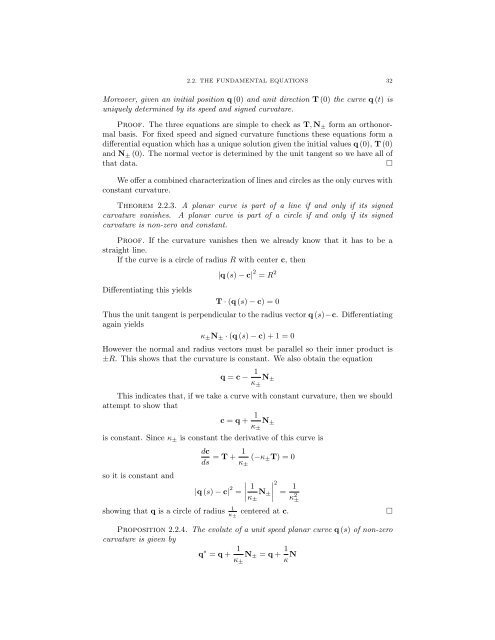Lecture Notes for 120 - UCLA Department of Mathematics
Lecture Notes for 120 - UCLA Department of Mathematics
Lecture Notes for 120 - UCLA Department of Mathematics
Create successful ePaper yourself
Turn your PDF publications into a flip-book with our unique Google optimized e-Paper software.
2.2. THE FUNDAMENTAL EQUATIONS 32<br />
Moreover, given an initial position q (0) and unit direction T (0) the curve q (t) is<br />
uniquely determined by its speed and signed curvature.<br />
Pro<strong>of</strong>. The three equations are simple to check as T, N ± <strong>for</strong>m an orthonormal<br />
basis. For fixed speed and signed curvature functions these equations <strong>for</strong>m a<br />
differential equation which has a unique solution given the initial values q (0), T (0)<br />
and N ± (0). The normal vector is determined by the unit tangent so we have all <strong>of</strong><br />
that data.<br />
⇤<br />
We <strong>of</strong>fer a combined characterization <strong>of</strong> lines and circles as the only curves with<br />
constant curvature.<br />
Theorem 2.2.3. A planar curve is part <strong>of</strong> a line if and only if its signed<br />
curvature vanishes. A planar curve is part <strong>of</strong> a circle if and only if its signed<br />
curvature is non-zero and constant.<br />
Pro<strong>of</strong>. If the curvature vanishes then we already know that it has to be a<br />
straight line.<br />
If the curve is a circle <strong>of</strong> radius R with center c, then<br />
Differentiating this yields<br />
|q (s) c| 2 = R 2<br />
T · (q (s) c) =0<br />
Thus the unit tangent is perpendicular to the radius vector q (s)<br />
again yields<br />
apple ± N ± · (q (s) c)+1=0<br />
c. Differentiating<br />
However the normal and radius vectors must be parallel so their inner product is<br />
±R. This shows that the curvature is constant. We also obtain the equation<br />
q = c<br />
1<br />
apple ±<br />
N ±<br />
This indicates that, if we take a curve with constant curvature, then we should<br />
attempt to show that<br />
c = q + 1<br />
apple ±<br />
N ±<br />
is constant. Since apple ± is constant the derivative <strong>of</strong> this curve is<br />
so it is constant and<br />
dc<br />
ds = T + 1 (<br />
apple ±<br />
apple ± T)=0<br />
|q (s) c| 2 = 1<br />
apple ±<br />
N ±<br />
2<br />
= 1<br />
apple 2 ±<br />
showing that q is a circle <strong>of</strong> radius 1<br />
apple ±<br />
centered at c. ⇤<br />
Proposition 2.2.4. The evolute <strong>of</strong> a unit speed planar curve q (s) <strong>of</strong> non-zero<br />
curvature is given by<br />
q ⇤ = q + 1<br />
apple ±<br />
N ± = q + 1 apple N
















